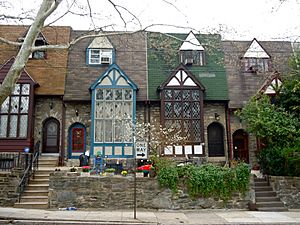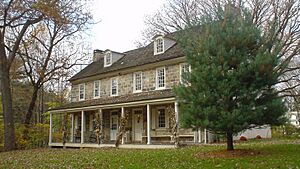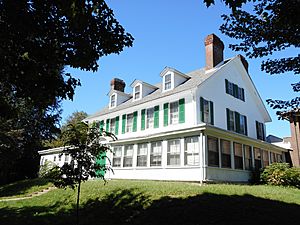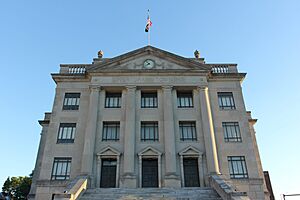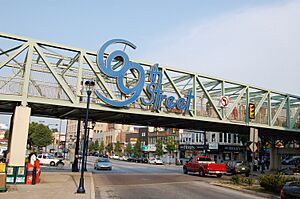Upper Darby Township, Pennsylvania facts for kids
Quick facts for kids
Upper Darby, Pennsylvania
|
|
|---|---|
|
Home rule township
|
|
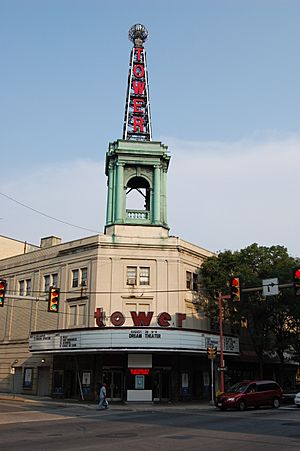
Tower Theater in Upper Darby Township
|
|
| Nickname(s):
UD
|
|
| Motto(s):
"The World in One Place"
|
|
| Country | |
| State | |
| County | Delaware |
| Settled | 1653 |
| Incorperation | 1736 |
| Government | |
| • Type | Mayor–council |
| Area | |
| • Total | 7.83 sq mi (20.27 km2) |
| • Land | 7.83 sq mi (20.27 km2) |
| • Water | 0.00 sq mi (0.00 km2) |
| Elevation | 230 ft (70 m) |
| Population
(2020)
|
|
| • Total | 85,681 |
| • Density | 10,559.62/sq mi (4,076.89/km2) |
| Time zone | UTC-5 (EST) |
| • Summer (DST) | UTC-4 (EDT) |
| ZIP Code |
19082
|
| Area code(s) | 610 and 484 |
| FIPS code | 42-045-79000 |
Upper Darby Township, often called Upper Darby, is a special kind of township in Delaware County, Pennsylvania, United States. It's known as a "home rule" township, meaning it has more control over its own local laws. In 2020, about 85,681 people lived here. This makes it the sixth-largest town or city in Pennsylvania.
Upper Darby is right next to Philadelphia, which is one of the biggest cities in the U.S. It's also part of the larger Philadelphia area, called the Delaware Valley. This area is the seventh-largest metropolitan area in the country.
You can find the famous Tower Theater in Upper Darby. It's a historic music place on 69th Street that was built in the 1920s. The township also has several important sites from the Underground Railroad, a secret network that helped enslaved people find freedom.
Contents
History of Upper Darby
Early Settlement and the 1600s

For thousands of years, the Lenape tribe of Native Americans lived in the area that became Upper Darby. They were part of the Woodland culture, living in longhouses and birch bark homes. They grew crops like winter squash, corn, and beans together.
The first European settlers arrived in late 1653. They were a group from New Sweden. In 1655, the Dutch took over New Sweden. Then, in 1664, the English gained control as they conquered New Amsterdam. The English king owned the land until he gave a large part of it to William Penn in 1681.
When Penn started the colony of Pennsylvania in 1682, this area became part of Darby Township in Chester County. Later, on September 26, 1789, the eastern part of Chester County split off to form Delaware County.
The Lower Swedish Cabin, built around 1654, is on Creek Road along the Darby Creek. Many believe it's a reminder of the early Swedes, who brought the idea of the log cabin to this area. Today, the "Swedish Cabin" is a Pennsylvania Historical Marker and is on the National Register of Historic Places.
The 1700s and Separation
Darby Township originally covered a large area. This included the northern part that is now Upper Darby. In 1747, people decided to split the township into two parts for easier management. The northern part became known as Upper Darby Township.
The exact border was set in 1786. It followed Cobb's Creek, Darby Creek, and the lines of various land owners. This separation made it easier for people in the northern part to handle their local matters.
Upper Darby had many creeks and streams. This was perfect for building mills. Some of the first mills in Delaware County were in Upper Darby. Examples include the Cardington Mills and the Kent Mills. The site of the former Kent Mills is now Kent Park, a recreation area. The Garrett family, who owned mills along Darby Creek, were also important local mill owners.
The 1800s and Growth
Besides mills, Upper Darby had rock quarries and factories. These industries helped the township grow a lot. The population went from about 800 people in 1800 to almost 5,000 by 1890. This growth led to more homes and businesses. Many European immigrants moved to the area. New churches were also built to serve these new residents.
However, this growth also meant that some parts of the township became very populated. Starting in 1885, these areas asked the state to become separate towns. This is how Clifton Heights (1885), Lansdowne (1893), Aldan (1893), Millbourne (1909), and East Lansdowne (1911) became their own boroughs.
Upper Darby's early English settlers were often Quakers. Quakers were against slavery. Because of this, Upper Darby was very active in the movement to end slavery. Many homes in the area were stops on the Underground Railroad. This secret network helped enslaved people escape to freedom.
One such home was Hoodland, owned by abolitionist Abraham L. Pennock. Today, this house is part of the township's public library. Another important abolitionist, Thomas Garrett, grew up in Upper Darby. His home, Thornfield, still stands today.
Upper Darby also played a role in the American Civil War. Two regiments from Upper Darby fought in the war. This included the 106th Pennsylvania Infantry Regiment, which fought in major battles like Antietam and Gettysburg.
The 1900s and Modernization
In 1907, the Philadelphia Rapid Transit Company saw that Upper Darby was growing. They extended the Market-Frankford elevated train line (the "El") to 69th and Market Streets in Upper Darby. The 69th Street Station became a busy hub. It connected to trolleys, light rail, and many bus routes.
This made the 69th Street area a major shopping district in the 1920s. Upper Darby became the second-busiest shopping area in the region, after Center City Philadelphia. Many buildings in this area have a cool Art Deco style. The population continued to grow, and by the 1960s, Upper Darby was one of Pennsylvania's most populated towns.
In the early 1970s, students from Highland Park Elementary School started a campaign. They wanted the Pennsylvania Firefly to be the official state insect of Pennsylvania. With help from state legislators, they wrote letters and collected signatures. On April 10, 1974, Governor Milton J. Shapp signed their bill. The Pennsylvania Firefly became the state's official insect!
The 2000s and Community Spirit
In 2020, the community voted on a motto for Upper Darby: "The World in One Place." This motto shows how many different cultures live together in the township today.
Upper Darby has also seen more activism for LGBTQ rights. Upper Darby Pride, a non-profit group, planned the first Upper Darby Pride Fest for June 2020. It was canceled due to the COVID-19 pandemic. However, it was held a year later and has grown into Delaware County Pride, with its first festival in Downtown Upper Darby in June 2023.
Geography and Location
Upper Darby Township covers about 7.9 square miles (20.4 square kilometers) of land. It sits on the edge of the Piedmont region, a bit higher than Philadelphia. The elevation ranges from 60 to 260 feet (18 to 79 meters) above sea level. Several small creeks flow through the area.
The borough of East Lansdowne is completely surrounded by Upper Darby Township. This makes East Lansdowne an enclave. Upper Darby also has a small piece of land, called an exclave, that is separated from the rest of the township.
Upper Darby has many neighborhoods, including Aronimink, Beverly Hills, Bywood, Drexel Hill, Fernwood, Highland Park, and Stonehurst.
Cobbs Creek runs along the border of Upper Darby and connects with Darby Creek. Cobbs Creek Park and a Philadelphia golf course are next to the Highland Park neighborhood, near the border with Philadelphia's Overbrook Park neighborhood.
Upper Darby Neighborhoods
- Addingham
- Aronimink
- Beverly Hills
- Bywood
- Cardington
- Drexel Hill
- Fernwood
- Highland Park
- Kirklyn
- Penn Pines
- Primos
- Secane
- Terminal Square
- Stonehurst Hills
- Walnut Park
- Westbrook Park
Nearby Towns and Communities
Upper Darby is surrounded by many other towns and communities:
- Cobbs Creek, Philadelphia – to the east
- Millbourne Borough, Delaware County – to the northeast
- Overbrook Park, Philadelphia – to the north
- East Lansdowne Borough, Delaware County – to the southeast
- Yeadon Borough, Delaware County – to the southeast
- Lansdowne Borough, Delaware County – to the south
- Darby Borough, Delaware County – to the south
- Clifton Heights, Delaware County – to the south
- Aldan Borough, Delaware County – to the south
- Darby Township, Delaware County – to the south
- Ridley Township, Delaware County – to the southwest
- Springfield Township, Delaware County – to the west
- Haverford Township, Delaware County – to the west
Climate Information
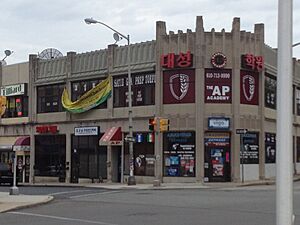
Upper Darby has a humid subtropical climate. This means it has hot, humid summers and mild winters. The average monthly temperatures range from about 33°F (0.5°C) in January to 78°F (25.5°C) in July.
Population and Diversity
| Historical population | |||
|---|---|---|---|
| Census | Pop. | %± | |
| 1900 | 3,821 | — | |
| 1910 | 5,385 | 40.9% | |
| 1920 | 8,956 | 66.3% | |
| 1930 | 47,145 | 426.4% | |
| 1940 | 56,883 | 20.7% | |
| 1950 | 84,951 | 49.3% | |
| 1960 | 93,158 | 9.7% | |
| 1970 | 95,910 | 3.0% | |
| 1980 | 84,054 | −12.4% | |
| 1990 | 81,777 | −2.7% | |
| 2000 | 81,821 | 0.1% | |
| 2010 | 82,795 | 1.2% | |
| 2020 | 85,681 | 3.5% | |
| U.S. Decennial Census | |||
Upper Darby is known for being one of Pennsylvania's most diverse communities. Many different cultures and backgrounds are represented here.
2020 Census Data
The 2020 census showed the different groups of people living in Upper Darby Township:
| Group | Pop 2000 | Pop 2010 | Pop 2020 | % 2000 | % 2010 | % 2020 |
|---|---|---|---|---|---|---|
| White (not Hispanic) | 62,525 | 45,341 | 33,961 | 76.42% | 54.76% | 39.64% |
| Black or African American (not Hispanic) | 9,124 | 22,341 | 30,291 | 11.15% | 26.98% | 35.35% |
| Native American or Alaska Native (not Hispanic) | 75 | 119 | 125 | 0.09% | 0.14% | 0.15% |
| Asian (not Hispanic) | 7,227 | 9,182 | 10,878 | 8.83% | 11.09% | 12.70% |
| Pacific Islander (not Hispanic) | 20 | 29 | 24 | 0.02% | 0.04% | 0.03% |
| Other race (not Hispanic) | 103 | 178 | 556 | 0.13% | 0.21% | 0.65% |
| Mixed race (not Hispanic) | 1,404 | 1,850 | 3,108 | 1.72% | 2.23% | 3.63% |
| Hispanic or Latino (any race) | 1,343 | 3,755 | 6,738 | 1.64% | 4.54% | 7.86% |
| Total Population | 81,821 | 82,795 | 85,681 | 100.00% | 100.00% | 100.00% |
In 2019, three members of the LGBTQ community were elected to the Upper Darby School Board.
Religious Places
Upper Darby has many different places of worship. The Roman Catholic Archdiocese of Philadelphia runs several Catholic churches, including St. Andrew, St. Bernadette, St. Charles Borromeo, St. Dorothy, and St. Laurence.
Other religious centers include Soji Zen Center (a Buddhist Temple), Masjid Al-Madinah Islamic Center (a mosque), Sree Sree Sanatan Shangho (a Hindu Temple), and St Demetrios Greek Orthodox Church. There are also many Protestant churches, such as Presbyterian, Baptist, United Methodist, and Lutheran churches.
Arts and Culture Scene
The Tower Theater is a famous place for music and shows. It opened in 1927 as a movie and vaudeville theater. Since 1972, it has been a concert venue, hosting famous acts like David Bowie and Genesis. Rolling Stone magazine even called it one of the ten best live music venues in the U.S. in 2018.
Upper Darby Summer Stage is one of the oldest youth theater programs in the country. It gives young people a chance to perform.
The annual Music Man Festival is held at Greenhorn Gardens. It features live music, food, and raises money for arts programs.
The Upper Darby International Festival happens every September. It celebrates the many different cultures in Upper Darby with performances, art, and food.
The Upper Darby Art Gallery opened in 2018. It shows art from local and international artists and offers art classes.
Upper Darby's restaurants offer a wide variety of foods. You can find Vietnamese, Thai, Japanese, Liberian, Indian, Italian, Korean, Mexican, and Colombian food. The area also has many Irish pubs. The Llanerch Diner was even featured in the movie Silver Linings Playbook.
The Philadelphia Museum of Art once had a branch museum on 69th Street from 1930 to 1933. The University of Pennsylvania also had an observatory here from 1897 to 1956. This site is now Observatory Park.
Historic Places to Visit
- Arlington Cemetery was once Riverview Farm, a stop on the Underground Railroad. There's a small museum there.
- Collen Brook Farm was added to the National Register of Historic Places in 1988. It was the home of a political leader named George Smith.
- Lower Swedish Cabin is believed to be the oldest building in Pennsylvania, built around 1654. It's also on the National Register of Historic Places.
- Sellers Hall is another very old building, with parts built in 1684. It was the home of the Sellers family, one of Upper Darby's first families. Sellers Hall also helped as an Underground Railroad station.
- Thornfield was the home of abolitionist Thomas Garrett, built around 1800.
- Downtown Terminal Square has several beautiful Art Deco buildings, especially around the McClatchy Building.
Local Libraries
Upper Darby Township has three public libraries that are part of the Delaware County Library System:
- Sellers Memorial Free Library
- Free Library Municipal Branch
- Free Library Primos Branch
Cemeteries
Upper Darby has several cemeteries:
- Friends Southwestern Burial Ground, a Quaker cemetery started in 1860.
- Fernwood Cemetery, a private cemetery started in 1870.
- Arlington Cemetery, a non-religious cemetery started in 1895.
- Har Jehuda Cemetery, a Jewish cemetery started in 1896.
- Montrose Cemetery, a private cemetery started in 1896.
Education in Upper Darby
Public Schools
The Upper Darby School District provides public education for the township. There are 12 public schools and a Kindergarten Center, serving almost 12,000 students. The district has one high school, Upper Darby High School, and two middle schools, Beverly Hills Middle School and Drexel Hill Middle School. There are also 10 elementary schools. Students from Secane, Clifton Heights, and Millbourne also attend schools in the Upper Darby School District. Upper Darby High School, founded in 1895, is one of the largest high schools in Pennsylvania, with nearly 4,000 students.
Private Schools
Upper Darby also has several private and religious schools. Monsignor Bonner High School (for boys) and Archbishop Prendergast High School (for girls) are the largest private schools. Both are Roman Catholic high schools with many students. There are also nine Catholic primary and middle schools in the township. Most of these schools are run by the Archdiocese of Philadelphia.
Catholic schools for grades K-8 include:
- Saint Andrew School (Drexel Hill)
- St. Bernadette of Lourdes School (Drexel Hill)
- St. Dorothy School (Drexel Hill)
- St. Eugene School (Primos)
- St. Laurence School (Highland Park)
Higher Education and Adult Learning
The Upper Darby Adult Evening Program (UDAEP) offers classes for adults. These classes help with job skills and general education. UDAEP is a non-profit group separate from the school district.
Delaware County Community College has an Upper Darby Center. It offers day and evening classes to about 600 students.
Transportation and Services
Getting Around Upper Darby

SEPTA's 69th Street Transportation Center is a major transportation hub. It's the end stop for the Market–Frankford Line (the "El") and the Norristown High Speed Line. It also serves SEPTA trolley routes 101 and 102, and many bus routes. The Norristown High Speed Line has other stops in Upper Darby at 69th Street and Parkview station.
SEPTA Regional Rail's Media/Wawa Line goes through the southern part of Upper Darby. It has stations at Secane and Primos.
Upper Darby Township has over 150 miles of public roads. Most of these are maintained by the township itself.
Pennsylvania Route 3 (Market Street and West Chester Pike) runs through the northern part of Upper Darby. U.S. Route 1 follows Township Line Road on the northwestern edge. U.S. Route 13 goes through the southeastern corner.
Emergency Services
Upper Darby Township has its own police department with 133 members. Paramedics from Crozer-Keystone North Division also serve the area.
The Upper Darby Township Fire Department is made up of both paid and volunteer firefighters. It has a main building and five fire stations:
- Company 20 – Garrettford-Drexel Hill (volunteer station)
- Company 26 – Highland Park
- Company 36 – Cardington-Stonehurst
- Company 37 – Upper Darby
- Company 74 – Primos-Secane-Westbrook Park
Notable People from Upper Darby
Many interesting people have come from Upper Darby:
- Lloyd Alexander (1924–2007), a famous author.
- Tina Fey (born 1970), a well-known comedian, writer, and actress.
- Dick Clark (1929–2012), a famous entertainer.
- Jim Croce (1943–1973), a popular singer and songwriter.
- Robert Crumb (born 1943), a cartoonist.
- Ed McMahon (1923–2009), co-host of Tonight Show with Johnny Carson.
- Cheri Oteri (born 1962), a comedian and actress.
- Todd Rundgren (born 1948), a singer, songwriter, and music producer.
- Mike Scioscia (born 1958), a baseball player and manager for the Los Angeles Angels.
- William Wharton (1925–2008), an author.
- Thomas Garrett (1789–1871), an important abolitionist.
- Abraham L. Pennock (1786–1868), an abolitionist and inventor.
- John Cappelletti (born 1952), an NFL football player.
- Simoni Lawrence (born 1989), a football player.
- Paul Westhead (born 1939), an NBA basketball coach.
- Jamie Kennedy (born 1970), a comedian.
- Monica Horan (born 1963), an actress.
Images for kids
See also
 In Spanish: Municipio de Upper Darby para niños
In Spanish: Municipio de Upper Darby para niños




